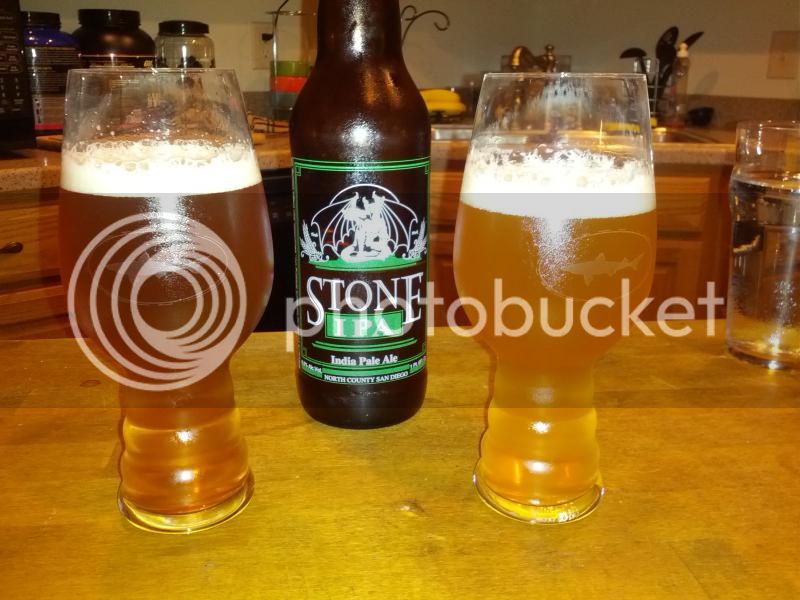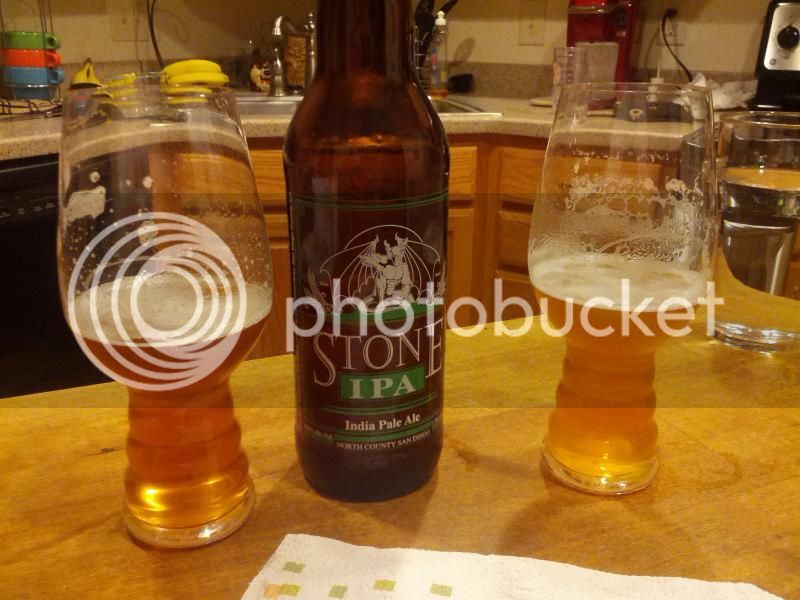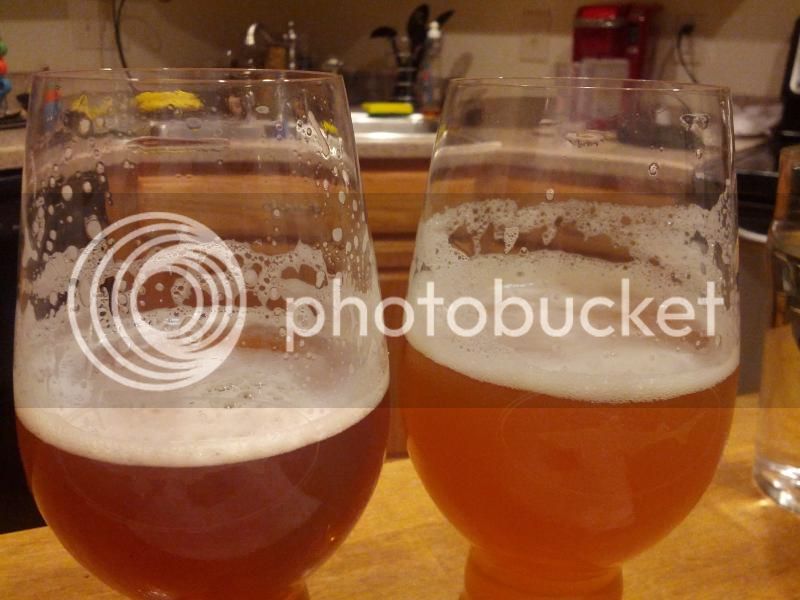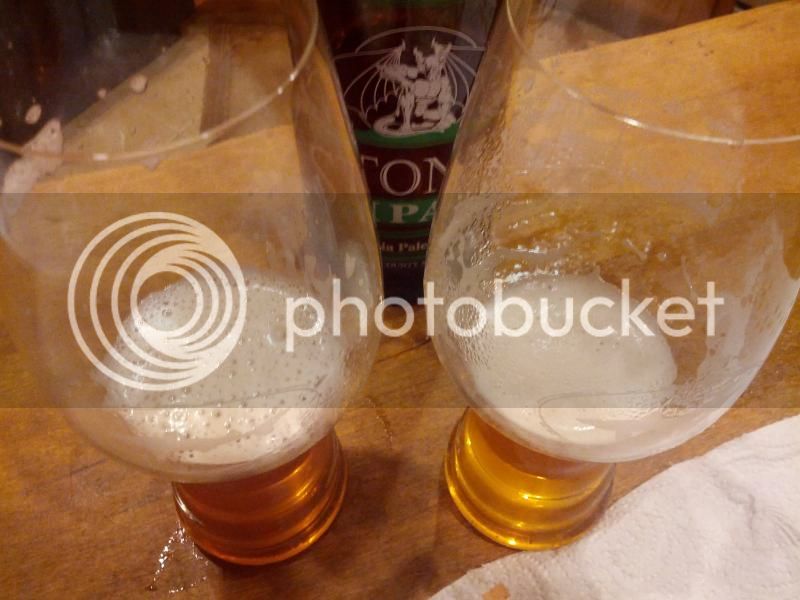And by first AG brew, I mean my first brew day period! I skipped extract, BIAB, partial mash, bottling, etc. Built a GE 7.0 three tap keezer with 525ss Perlicks, SS shanks & nipple, 10# aluminum CO2 tank, 4-way manifold, etc controlled by a digital A149. Also built a Fermentation chamber using a GE 5.0 and STC-1000 dual stage (cooling only hooked plugged in for summer).
Equipment - two 15gal Spike Brewing SS kettles with 3-piece SS ball valves and sight glass for HLT and BK. 10gal Industrial Igloo cooler with False bottom for Mash tun. Wooden Kero mash paddle, all silicon hosing, Blichmann burner, Ale Pails, etc etc.
Anyways, for my very first brew ever I did a Stone IPA clone 5.5 gallon (EdWort's). I entered 5.5 gal in BeerSmith vs 5.0gal to account for hop gunk and trub and hit all my volumes.
10.5# 2-row
1# Munich
1# Crystal 40 (they didn't have 20L)
1oz Warrior hops @ 60min
1oz Centennial hops @ 15min (1tsp Irish Moss as well)
1oz Centinnial hops @ 5min
Dry hopping in Keg with 1oz Centennial in a SS herb ball
I used a Cereal Killer Grain Mill and crushed everything myself with a power drill at low speed. I hit my mash temp very close, possibly a bit high, 153-154 several areas I checked (TW8060). Did a 60min mash and only lost about 0.5 degrees. Single batch sparge with 175* water, stirred for a few min, let settle for 10min, and then drained. Boil went smooth, threw in the Immersion Chiller in @ 20 min. Flame out and hit the garden hose realizing I had a bit of a leak that was splashing a bit of water into the Kettle :smack: Ran inside and grabbed some tools and fixed it and cooled the wort down to about 75* in about 15 min. I then grabbed an ale pail that I had soaked in PBW, rinsed, and then filled with StarSan, dumped it into another clean pail and used it for the fermenter along with a sanitized 3 piece air lock. I wanted to try out my stir plate but did not have enough time to do one and chill/decant in time so I aerated the wort and sprinkled an 11.5g packet of dry US-05 yeast.
OG was a bit low, 1.054. I'm thinking because my mash temp was slightly higher than anticipated I forgot to check my SG after the mash so I don't know my effeciency It tasted a bit sweeter than expected with very forward hop notes.
It tasted a bit sweeter than expected with very forward hop notes.
Right now it is sitting in the fermentation chamber at ~63* and I have yet to hear any bubbling out the air lock. It's been about 20 hours since I pitched. Trying to hold off peeking inside the bucket or getting too worried! If I haven't seen any activity by 3 full days I was thinking of pitching another packet of US-05 (Mr. Malty said 1.2 packets) and re-aerating.
I cleaned everything pre-boil with PBW and rinsed hot, and additionally used StarSan for anything post-boil. I also used a MoreBeer water filtration system for all the water.
Any tips/hints/comments for my first beer ever??? I'm thinking of building some sort of pickup tube for the BK as there was some wort that I missed out on due to the height of the ball valve. I did sort of whirlpool with the IC and then drained. I've learned a lot reading on here for the past few months and obviously went way overboard with my equipment from the get-go! Had a blast and next on-deck I'm planning is a Founder's Breakfast Stout Clone! :rockin:
Now I'll just have to make sure everything goes right with kegging....
Equipment - two 15gal Spike Brewing SS kettles with 3-piece SS ball valves and sight glass for HLT and BK. 10gal Industrial Igloo cooler with False bottom for Mash tun. Wooden Kero mash paddle, all silicon hosing, Blichmann burner, Ale Pails, etc etc.
Anyways, for my very first brew ever I did a Stone IPA clone 5.5 gallon (EdWort's). I entered 5.5 gal in BeerSmith vs 5.0gal to account for hop gunk and trub and hit all my volumes.
10.5# 2-row
1# Munich
1# Crystal 40 (they didn't have 20L)
1oz Warrior hops @ 60min
1oz Centennial hops @ 15min (1tsp Irish Moss as well)
1oz Centinnial hops @ 5min
Dry hopping in Keg with 1oz Centennial in a SS herb ball
I used a Cereal Killer Grain Mill and crushed everything myself with a power drill at low speed. I hit my mash temp very close, possibly a bit high, 153-154 several areas I checked (TW8060). Did a 60min mash and only lost about 0.5 degrees. Single batch sparge with 175* water, stirred for a few min, let settle for 10min, and then drained. Boil went smooth, threw in the Immersion Chiller in @ 20 min. Flame out and hit the garden hose realizing I had a bit of a leak that was splashing a bit of water into the Kettle :smack: Ran inside and grabbed some tools and fixed it and cooled the wort down to about 75* in about 15 min. I then grabbed an ale pail that I had soaked in PBW, rinsed, and then filled with StarSan, dumped it into another clean pail and used it for the fermenter along with a sanitized 3 piece air lock. I wanted to try out my stir plate but did not have enough time to do one and chill/decant in time so I aerated the wort and sprinkled an 11.5g packet of dry US-05 yeast.
OG was a bit low, 1.054. I'm thinking because my mash temp was slightly higher than anticipated I forgot to check my SG after the mash so I don't know my effeciency
Right now it is sitting in the fermentation chamber at ~63* and I have yet to hear any bubbling out the air lock. It's been about 20 hours since I pitched. Trying to hold off peeking inside the bucket or getting too worried! If I haven't seen any activity by 3 full days I was thinking of pitching another packet of US-05 (Mr. Malty said 1.2 packets) and re-aerating.
I cleaned everything pre-boil with PBW and rinsed hot, and additionally used StarSan for anything post-boil. I also used a MoreBeer water filtration system for all the water.
Any tips/hints/comments for my first beer ever??? I'm thinking of building some sort of pickup tube for the BK as there was some wort that I missed out on due to the height of the ball valve. I did sort of whirlpool with the IC and then drained. I've learned a lot reading on here for the past few months and obviously went way overboard with my equipment from the get-go! Had a blast and next on-deck I'm planning is a Founder's Breakfast Stout Clone! :rockin:
Now I'll just have to make sure everything goes right with kegging....


 I think I'll let this one slide and then plan on blow off tube for my next beers when I hydrate the US-05 or make a starter off something else.
I think I'll let this one slide and then plan on blow off tube for my next beers when I hydrate the US-05 or make a starter off something else.





